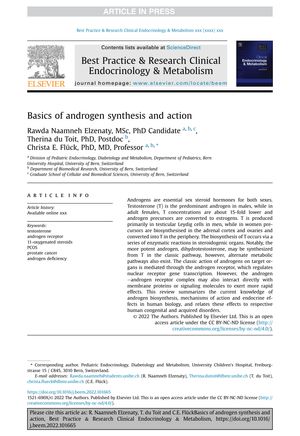TLDR Androgens like testosterone are important hormones for both men and women, made differently in each sex and affecting the body by regulating genes and quick interactions with cell components.
Androgens, including testosterone (T), are critical sex hormones for both males and females, with males having significantly higher concentrations. Testosterone is primarily produced in men's testicular Leydig cells, while in women, it is synthesized from precursors in the adrenal cortex and ovaries and then converted in peripheral tissues. Dihydrotestosterone, a more potent androgen, can be synthesized from testosterone through the classic pathway, but alternative pathways also exist. Androgens exert their effects through the androgen receptor, which regulates gene transcription in the nucleus, but they can also have rapid effects by interacting directly with membrane proteins or signaling molecules. This review provides an overview of androgen biosynthesis, action mechanisms, and their role in human biology, including their involvement in various congenital and acquired disorders.
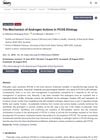 30 citations
,
August 2019 in “Medical Sciences”
30 citations
,
August 2019 in “Medical Sciences” Androgens play a key role in causing PCOS (Polycystic Ovary Syndrome).
120 citations
,
April 2019 in “The Journal of clinical investigation/The journal of clinical investigation” Both estrogens and androgens are important for health in both males and females.
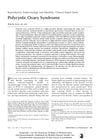 257 citations
,
July 2018 in “Obstetrics & Gynecology”
257 citations
,
July 2018 in “Obstetrics & Gynecology” PCOS is a complex disorder in women that can lead to various health risks and requires personalized treatment.
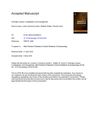 82 citations
,
May 2016 in “Best Practice & Research in Clinical Obstetrics & Gynaecology”
82 citations
,
May 2016 in “Best Practice & Research in Clinical Obstetrics & Gynaecology” The conclusion is that managing androgen excess requires long-term treatment, including hormonal contraceptives and androgen blockers, with follow-up after six months.
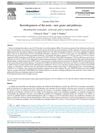 70 citations
,
April 2014 in “Annales d'endocrinologie”
70 citations
,
April 2014 in “Annales d'endocrinologie” New genes and pathways are important for testosterone production and male sexual development.
 23 citations
,
September 2021 in “Frontiers in Cellular and Infection Microbiology”
23 citations
,
September 2021 in “Frontiers in Cellular and Infection Microbiology” Testosterone's effects on COVID-19 are unclear and need more research.
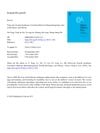 195 citations
,
November 2019 in “Clinica Chimica Acta”
195 citations
,
November 2019 in “Clinica Chimica Acta” High levels of male hormones, insulin resistance, and obesity are closely linked and worsen polycystic ovary syndrome, but more research is needed to improve treatments.
 May 2023 in “IntechOpen eBooks”
May 2023 in “IntechOpen eBooks” More research is needed to understand how testosterone is maintained in adult males.
3 citations
,
November 2021 in “IntechOpen eBooks” The testes produce important hormones like testosterone and others that play key roles in male body functions.
 February 2010 in “ePrints Soton (University of Southampton)”
February 2010 in “ePrints Soton (University of Southampton)” Male sexual differentiation is regulated independently, while female differentiation occurs in an androgenic environment, affecting conditions like congenital adrenal hyperplasia.
